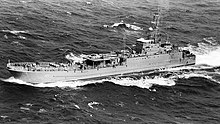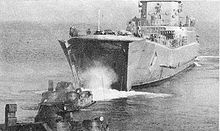Project 770/771/773
|
Project 771, with drain rails for remote-controlled clearing vehicles at the rear
|
||||||||||||||
|
||||||||||||||
|
||||||||||||||
|
||||||||||||||
|
||||||||||||||
Project 770 ( Russian Средние десантные корабли проекта 770 ; for Middle landing ship project 770 , NATO designation: północny class ), and the variants 771 and 773 were in a class of landing ships , which in Poland built in large numbers and by the Soviet Union and Poland was used in the Cold War .
From 1961, 46 ships of the Project 770 class were built. Project 771 had a slightly larger transport deck and was built with a total of 36 ships in the versions Project 771 and 771A from 1966. Compared to the original project 770, the final project 773 , of which 25 ships were built from 1970, displaced almost 50% more water.
variants
Model
- Project 770D: 550-t empty and 751-t maximum displacement, 1.85-m draft, dimensions 75 × 8.6-m transport deck 42 × 5.3 × 3.6-m
- Project 770MA: 600-t empty and 820-t maximum displacement, 1.95-m draft, dimensions 70 × 8.6-m
- Project 771: 640-t empty and 874-t maximum displacement, 2.06-m draft, dimensions 75 × 9-m, transport deck 44 × 5.3 × 3.6-m
- Project 771A: 650-t empty and 884-t maximum displacement, 2.07-m draft, dimensions 75 × 9-m
- Project 773: 920-t empty and 1192-t maximum displacement, 2.03-m draft, dimensions 81 × 9.3-m, transport deck 38 × 5.3 × 3.6-m
Armament


Each ship had two rocket launchers, each with 18 tubes for 140 mm BM-14 missiles . The launchers were installed approximately in the middle of the ship on bases with the firing direction forward, one each on port and starboard. The weapons were intended to help hold down the enemy defenses in support of their own landing forces at the moment of landing.
The equipment with anti-aircraft weapons was based mainly on whether the ships were intended for the Soviet Union or its allies. The Soviet ships usually received more modern equipment, while other navies used older equipment or only upgraded later.
The Soviet Project 770 ships were each equipped with a 30-mm-L / 63 AK-230 cannon or, in their place, a 25-mm-L / 70 2M-3 or a 14.5-mm-L / 90 2M- 7 equipped. In some cases launch devices for four by four Strela-2 anti-aircraft missiles were retrofitted later .
The Project 771A units and the ships of the subsequent Project 773 were each built with two 30 mm L / 63 AK-230 anti-aircraft guns, one in front and one behind the superstructure. For this purpose, two quadruple launch devices for Strela-3 anti-aircraft missiles were installed on the superstructures of these variants . Retrofitting of the Polish Project 771 ships included the installation of two quadruple launchers for the older Strela-2 anti-aircraft missiles.
Project 773 was armed with the two AK-230s of the previous class, but had no anti-aircraft missiles. Russia modernized one of the ships in 2007 with two 30mm L / 54 AK-630 automatic cannons.
description
Project 770 was designed for landing operations directly on the coast. Each ship had a gate in the ship's bow and a bow ramp for depositing vehicles, troops and material from the covered transport deck.
The transport capacity of all ships was similar. For project 771, for example, it is specified with up to six medium tanks or armored personnel carriers and an additional 200 soldiers. Alternatively, there was space for up to 10 trucks of the type ZIS-151 or comparable models.
Operational readiness
Of the 107 ships built since 1961, most of them were decommissioned, scrapped or sunk in 2016.
Of the 46 project 770 boats, 35 went to the Soviet Union, which gave 19 ships to friendly states. The remaining units were scrapped by 1997. Poland decommissioned all 10 ships or sold them abroad.
Of the 36 Project 771 boats, 25 went to the Soviet Union, which gave 12 to friendly states. Of the remaining ships, all of them were decommissioned by Russia by 1996. The Polish military decommissioned or surrendered all 11 ships by 1991.
The four Project 773 ships that the Soviet Union surrendered to Iraq were sunk in the First Gulf War in 1980 and in the Second Gulf War in 1990/1991. The status of the four ships surrendered to Libya is unclear after the air strikes of the International Military Operation in Libya in 2011 and the subsequent civil war in Libya . Russia decommissioned four of its eight 773 ships and handed one over to Ukraine. In 2016 India was still operating three of its originally eight Kumbhir class ships (Project 773i).
literature
- Ю.В.Апальков: Корабли ВМФ СССР. Том IV - Десантные и минно-тральные корабли. Saint Petersburg, 2007, ISBN 978-5-8172-0135-2 . (Russian)
Web links
- Project 770 at russianships.info (English)
- Project 771 at russianships.info (English)
- Project 773 at russianships.info (English)


